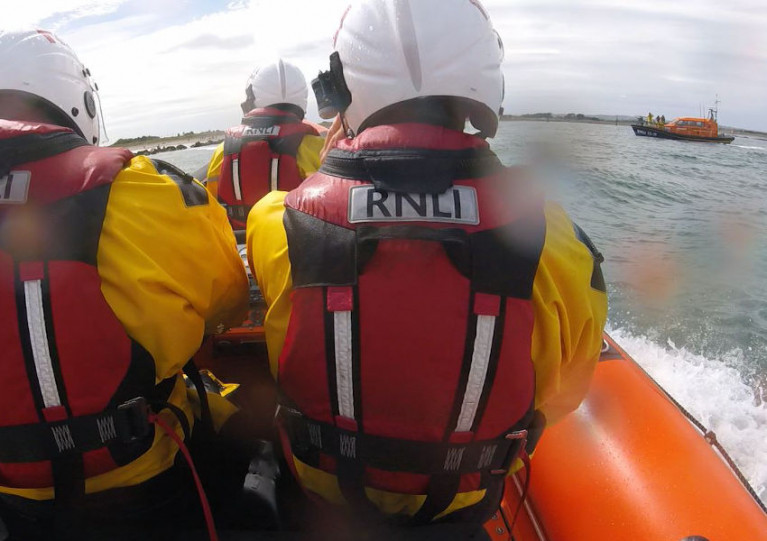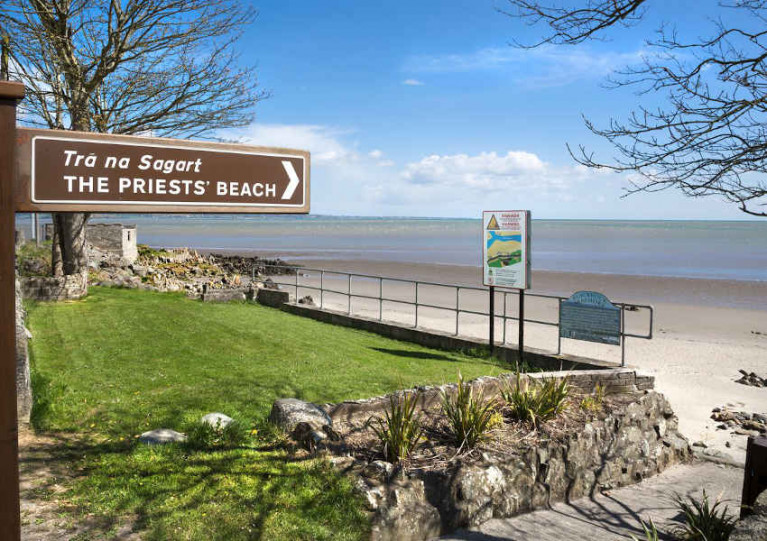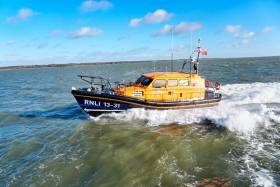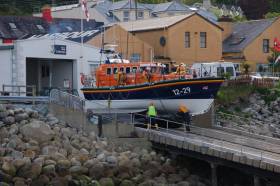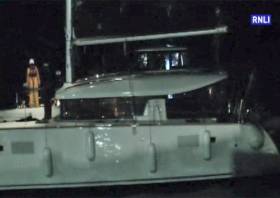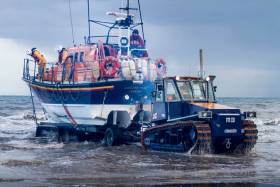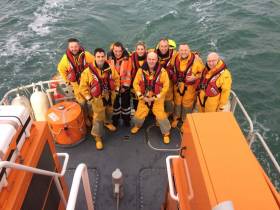Displaying items by tag: Clogherhead
End of an Era as Clogherhead RNLI Mechanic ‘Pops’ Retires After Four Decades Saving Lives at Sea
It is the end of an era at Clogherhead RNLI as long-serving lifeboat crewmember and station mechanic, Padraig Rath, affectionally known as ‘Pops’ has handed in his pager and officially retired from saving lives at sea this week. After four decades with the lifeboat charity, Pops took part in his last exercise on the lifeboat, which was witnessed by a large turnout made up of lifeboat crew personnel and fundraisers past and present, neighbouring lifeboat crew members along with family, friends, and supporters. It was a fitting send-off for the much-loved lifeboat mechanic who has been a constant and dedicated presence at Clogherhead lifeboat station for many years.
Born into a fishing family, Pops first went to sea as a young student in the summer of 1972. Losing his father at a young age, Pops went into fishing full time on completing his Leaving Cert before joining the Clogherhead lifeboat crew in 1982. He took on the role of Second Mechanic at the lifeboat station in 1991, becoming the Station Mechanic and Deputy 2nd Coxswain in 2000, on the retirement of Paddy Levins. With a young family to rear, Pops relished the role which would keep him in the community and doing what he loved. He was responsible for looking after the engines on the station’s Mersey class lifeboat Doris Bleasdale, making sure the lifeboat was ready to go to sea, night, or day and in any weather.
 Last one - Pops (centre) on his last exercise with Clogherhead RNLI Photo: Thomas Caffrey
Last one - Pops (centre) on his last exercise with Clogherhead RNLI Photo: Thomas Caffrey
His years as lifeboat crew have seen many changes and, in his time, the station has had three classes of lifeboats. When he joined the Oakley class was on station, which was followed by the Mersey class, before the latest Shannon class arrived in 2019. The Oakley lifeboat did 8 knots, the Mersey’s speed increased to 16 knots, while the Shannon reaches speeds of 25 knots. Each lifeboat bringing big changes and demands.
Pops has been on many callouts during his time on the lifeboat but the callout that stands out is the one he didn’t make. On holidays with his family in 1999, he rang home for the result of a local match when his mother told him about the Dunany tragedy, where four people drowned and four were rescued, when the boat they were in capsized. It was an enormous tragedy for the community. There was also a callout in 2011, where a group of primary school children who went kayaking, capsized, and ended up in the freezing water, not far from the lifeboat station. The large group were rescued by the lifeboat crew and taken to hospital, after being spotted in the water by the station’s Lifeboat Operations Manager. One of the parents keeps in touch to this day.
Pops has no plans to leave the RNLI behind. He is the station’s GAA Ambassador, a volunteer role for the partnership between the charity and the GAA, which sees the RNLI talking to clubs and supporters locally about water safety. He is also a passionate fundraiser for the lifeboat. While he will now relish the time he can spend with family and the extended breaks he can take time away from the station now that he is not on call.
Commenting on his retirement Clogherhead RNLI Lifeboat Operations Manager Declan Levins said, ‘I don’t think there are enough words to do justice to Pop’s legacy. The respect and affection the lifeboat crew and fundraisers have for him is clear and he has been the heart of this station for many years. He is so passionate about lifeboating and his enthusiasm for it was infectious. We are indebted to him for all his service, and I’m delighted he is staying involved with fundraising and the GAA/RNLI water safety work.’
Reflecting on his retirement Pops said, ‘I’ve had an amazing time being part of this incredible lifeboat crew and remarkable station. With each new class of lifeboat came new challenges. We were doing twice the speed and I was thinking twice as fast, but I loved it. It was a huge responsibility to make sure that the lifeboat would always bring the crew out to sea and always bring them and all casualties home safe. I’m proud of that. I’ll miss being out on the water but I’m leaving it in the very best of hands. I wish the very best of luck to the Crews, all involved with the station, their families and my successor Barry Sharkey and his family. May they always be safe when answering the “call” and return safely to their families.’
‘The Clogherhead lifeboat doesn’t belong to any one person, it’s the community’s lifeboat. They own it and every time we launch, we do it because they support us, and I hope they are proud of what we do.’
Lifeboat crew with Clogherhead RNLI had an early morning call out today (Wednesday 2 March) when they were requested to launch by Dublin Coast Guard to a 16m fishing vessel with five people onboard, that had suffered machinery issues a mile and half from Clogherhead.
Conditions were good with a force five to six onshore breeze. The volunteer crew launched the lifeboat at approximately 6.30 am and were quickly on scene. After making an assessment on the safest course of action, they took the vessel under tow and brought it to the nearest safe port at Port Oriel. They were back at the lifeboat station in under an hour, having brought the vessel to safety.
Commenting on the call out, Clogherhead RNLI Lifeboat Operations Manager Declan Levins said, ‘this was an early shout for the lifeboat crew and I’m grateful to them for getting the lifeboat launched so quickly to help the fishing crew. Thankfully conditions were not too bad out there but with the fishing vessel losing power, we needed to get them back to the safety of the shore as soon as possible.’
Five New Crew Members On Call for the First Time This Christmas at Sligo Bay RNLI
A busy mother of two young children is among five new volunteers who will be carrying pagers and on call for the first time this Christmas at Sligo Bay RNLI.
As the charity continues its Christmas Appeal, Rachel Wirtz is preparing to swap turkey and pudding and run to the lifeboat station should her pager go off.
She is urging people across Sligo to help her crew, and the thousands of other volunteer crews on call over the Christmas period, to continue their lifesaving work.
Rachel joined the crew over a year ago but due to the pandemic and restrictions, she couldn’t work on completing her assessments face-to-face until this year. While she has been involved in callouts as shore crew, she hasn’t yet made a lifeboat callout to sea.
“The standard and extent of the training has been excellent, and I am learning terrific new skills,” says the mum-of-three who lives in Rosses Point. “There was a rush of adrenaline and excitement rather than apprehension for my first call out. I am excited about being able to contribute and I feel very lucky to be a part of it.”
Among the other new lifeboat crew members at Sligo Bay RNLI are Reece Meldrum and Aisling Murphy, while Noah Canham and Caroline Collery have joined the shore crew. Yvette Carter, meanwhile, will be spending her first Christmas as a lifeboat helm.
Like Rachel, each RNLI crew member signs up to save every one from drowning — it has been the charity’s mission since 1824.
Rachel adds: “This is my first Christmas on call, and I know even over the festive period, our lifesavers are ready to drop everything at a moment’s notice and rush to the aid of someone in trouble on the water. At this time of year, the weather can be at its worst and lives can be on the line.
“We know that every time our crews go out, they hope for a good outcome, but sadly this sometimes isn’t the case. We hope that this year’s Christmas appeal will show people just how tough it can be, but also that with their help we can get so much closer to our goal of saving every one.”
 The four men taking on new roles with Clogherhead RNLI this Christmas
The four men taking on new roles with Clogherhead RNLI this Christmas
Meanwhile, on the East Coast, Clogherhead RNLI have appointed four people to new lifesaving roles as this Christmas the station stands ready to launch at a moment’s notice to save lives at sea.
Sean Flanagan, a pilot boat coxswain at Dublin Port, and Denis Levins, an officer with P&O Ferries, have been passed out as lifeboat coxswains, while Raymond Butterly has joined the station to become shore crew for launching the station’s impressive Shannon class lifeboat.
Barry Sharkey has also been appointed as the new full-time mechanic for the station, taking over from the retiring Padraig Rath.
The four men helped the charity launch its Christmas appeal at the Co Louth-based lifeboat station and are calling on the public to support the RNLI’s lifesaving work this Christmas, as they remain on call and ready to launch.
“We know that every time our crews go out, they hope for a good outcome, but sadly this sometimes isn’t the case,” says Barry, who comes from a well-known local fishing family. “Through people supporting this year’s Christmas appeal, with their help we can get so much closer to our goal of saving every one.”
To make a donation to the RNLI’s Christmas Appeal, visit RNLI.org/Xmas
RNLI lifeboat crews from Skerries and Clogherhead launched yesterday (Monday 25 May) to retrieve a number of adults and children who had become stranded on rocks near Mornington Beach, east of Drogheda.
The lifeboats were launched shortly before 3pm after Dublin Coast Guard received emergency calls about the group’s welfare.
Also tasked were the Irish Coast Guard’s Dublin-based helicopter Rescue 116, the Drogheda Coast Guard boat, and a coastguard land unit, with all arriving on scene within minutes.
Two women, a man and three children were located on the breakwater on the Mornington side of the River Boyne. It’s understood that the women and children had managed to climb up onto the rocks after they were pulled out to sea by a strong current, and the man had come to their assistance.
Working together, Skerries RNLI and Drogheda Coast Guard used their inshore boats to transfer the woman and one of the children to Clogherhead’s all-weather lifeboat for a possible transfer to the helicopter.
However, after consultation with the woman and Rescue 116, it was decided to bring them to a waiting ambulance on Mornington pier to be assessed and treated for their injuries.
The two inshore boats then recovered the remaining casualties from the rocks and brought them to be checked out by ambulance paramedics.
Subsequently the lifeboat crew were informed that another child had also been in the water and had suffered cuts and bruises.
However, they had made it back to shore with assistance from one of the adults. That child was picked up from the beach with another adult and brought for assessment by the ambulance crews.
Speaking about the call out, volunteer lifeboat press officer for Skerries RNLI, Gerry Canning, said: “Any incident involving multiple casualties has the potential to be serious.
“This was another great example of how well our volunteers work alongside our colleagues from our flank stations, from the coastguard and indeed all the emergency services.
“We hope all the casualties involved make a full and speedy recovery.”
Two Rescued After Incident At Co Louth Beach
The Irish Mirror reports that two people were rescued from a beach in Co Louth on Saturday afternoon (23 May) after getting into difficulty in the water.
Clogherhead RNLI and the Irish Coast Guard were tasked to the scene at Priests’ Beach in Blackrock, south of Dundalk,
And it’s understood the two individuals, who were surfers, were airlifted to hospital in Drogheda for treatment by the Dublin-based coastguard helicopter Rescue 116.
Clogherhead locals are set to welcome the latest RNLI lifeboat in Ireland to the Co Louth town this Sunday 2 June.
The Shannon class lifeboat Michael O’Brien lifeboat is due to arrive in Clogherhead at exactly 13.31 which is also its operation number.
This lifeboat is unique in the RNLI’s fleet as it has been funded by an Irish legacy, named after an Irish lifeboat volunteer, designed by an Irish engineer and is of the first class to be called after an Irish river.
Its arrival also marks the start of a new chapter in the story of search and rescue in the North East.
A significant proportion of Clogherhead lifeboat’s funding (apart from local fundraising appeals) has been provided through a generous legacy by a Wexford farmer, Mr Henry Tomkins, who was a lifelong supporter of the RNLI.
Henry stipulated that a lifeboat be named for his longtime friend, former Arklow RNLI coxswain Michael O’Brien.
The arrival of the station’s new Shannon lifeboat will take place in front of the beach beside the lifeboat station in full view of the public.
'It is the most technologically advanced lifeboat in the fleet, and it will proudly serve the east coast for many years to come'
It will also be the first time in Ireland that the RNLI will use a SLARS (Shannon Launch and Recovery System) to launch and recover a lifeboat in Ireland.
The SLARS acts as a mobile slipway for the lifeboat, which can be driven directly onto the beach for recovery. It has a unique turntable cradle, which can rotate the lifeboat 180 degrees, ready to be launched again within 10 minutes.
Clogherhead RNLI coxswain Tomás Whelahan said: “We want the people of Clogherhead and the surrounding areas to come to welcome the new lifeboat home.
“The station has been preparing for this day for a long time and there is huge excitement for it. The past few weeks and months have been spent in preparation and training by all the crew and shore crew, to receive this incredible piece of kit from the RNLI.
“It is the most technologically advanced lifeboat in the fleet, and it will proudly serve the east coast for many years to come.
“We are incredibly honoured to receive it and we are grateful to our donor Henry Tomkins and to the local communities, who by their generosity, have made this day possible. We hope to bring many loved ones safely home in this new lifeboat.”
Lifeboats from Clogherhead, Newcastle and Kilkeel were involved in the search for a woman missing in Carlingford Lough at the weekend, which came to a sad end yesterday afternoon (Monday 18 March) with the discovery of a body in the water off Greenore.
Newcastle RNLI was tasked to divert from a morning training exercise on the Co Down coast to join the major search operation which began on Sunday (17 March), concentrating on the entrance to Carlingford Lough and outlying islands.
During this search the all-weather lifeboat located a casualty in the water and, working with volunteer lifeboat crews from Clogherhead and Kilkeel RNLI, the casualty was taken ashore to Greenore Harbour by the Kilkeel lifeboat and placed in the care of An Garda Síochána.
The casualty was shortly after confirmed to be the remains of Ruth Maguire from Newcastle, who went missing during a hen party in Carlingford on Saturday night (16 March).
Speaking following the search, Newcastle RNLI coxswain Nathan Leneghan said: “On behalf of Newcastle RNLI I wish to express our deepest sympathy to the family and friends of the woman who was recovered from the water this afternoon.
“The thoughts and prayers of the everyone involved in the search are with them at this sad time. I also wish to commend the volunteer crews for their commitment and professionalism.”
Kilkeel RNLI lifeboat operations manager John Fisher added: “This was not the outcome we or the family wanted and at this difficult time our thoughts and prayers are with the family and friends of the casualty.
“At this time I would also like to thank the volunteer crew for their commitment and energy. We train for such an incident but always pray that it has a better outcome.”
Clogherhead Lifeboat Rescues New Zealand Catamaran & Crew
#RNLI - Clogherhead RNLI had a late-night callout on Wednesday 1 August to rescue the crew of a yacht that had got into difficulty.
At around 10.10pm, the Co Louth village’s all-weather lifeboat was requested by the Irish Coast Guard to go to the aid of a yacht that had become entangled in ropes some two-and-a-half miles north of Dunany Point.
The lifeboat quickly located the 45ft catamaran from New Zealand and helped free the vessel before towing it to safety in Port Oriel, where it was tied up at the pier around 1.20am.
Clogherhead Lifeboat Assists Medevac Of Injured Fisherman
#RNLI - Clogherhead RNLI assisted a fisherman in need of medical attention on Thursday evening (8 March).
The all-weather lifeboat was launched around 5.45pm following a request for a medevac from a small fishing boat operating off Gormanstown and north-east of Braymore Point in Balbriggan.
On arrival at the scene, members of the volunteer lifeboat crew boarded the fishing vessel to attend to the casualty and assess the situation.
The casualty, who had received a leg injury, was stabilised by the lifeboat crew and then carefully transferred by stretcher on to the lifeboat.
The Irish Coast Guard helicopter Rescue 116 from Dublin also attended the scene and was hovering close by. A paramedic from the helicopter crew provided further treatment before the casualty was winched aboard.
Speaking afterwards, Clogherhead RNLI coxswain Tomás Whelehan said: “We would like to wish the casualty a speedy recovery following his ordeal.
“This rescue demonstrated the value of our ongoing training and as lifeboat crew and also highlights the importance of joint working with our colleagues in the Irish Coast Guard.”
PJ Gallagher & Friends To Hold Dun Laoghaire Comedy Night In Aid Of RNLI
#RNLI - Comedian, radio host and TV personality PJ Gallagher is to hold a night of fun and laughter with some of Ireland’s top comedians to raise funds for the RNLI.
The one-off event is being staged at Dun Laoghaire’s Pavilion Theatre on Sunday 4 March, where PJ will be joined by friends Deirdre O’Kane, Eric Lalor, Joanne McNally and more.
Funds raised on the night will go to help the charity with their work in saving lives at sea and prevention.
PJ became aware of the work of the RNLI in Dun Laoghaire when he was passing the station and lifeboat mechanic Kieran ‘Colley’ O’Connell invited him in to look around.
The pair struck up a friendship, and PJ has been a regular visitor at the station since then. When he heard about he work of the RNLI he made up his mind to do an event to raise funds.
Speaking about his decision to hold the comedy night and to ask some of his famous friends to support it, PJ said: “I live near the lifeboat station and was aware of the work of the RNLI but it was only when I met Colley that I really learned what it was all about. These men and women are volunteers and they leave their jobs and lives to come and help those in trouble at sea.
“We have a big beautiful lifeboat on view in Dun Laoghaire Harbour but when it’s gone, sometimes in the middle of the night, that’s when they are doing their amazing work. I asked some friends if they’d help with a fundraiser and they jumped at the chance. In fairness, you never know when this lot might need rescuing.”
Kieran added: “We are really thrilled that PJ and his friends are holding this night for us. We get a lot of visitors into the station and they are always delighted to hear about the work we do and you hope it stays with them but PJ has stayed in contact and become a firm friend of the station.
“I just hope he knows what he is letting himself in for as most of the crew will be attending and if their pagers go off there could be a lot of people running for the doors suddenly. I hope they won’t take it personally.”
The gig is selling fast, with only a small number of tickets remaining. Tickets are priced at €24 and are available from the box office directly at www.paviliontheatre.ie or 01 231 2929.
Night at the Oskars
Elsewhere, members of Clogherhead RNLI have been overwhelmed with the local support for ‘The Night at the Oskars’, a special night being staged to raise funds for the station’s new Shannon class lifeboat due in 2019.
Taking place on Saturday 3 March at the TLT in Drogheda, the evening will see local people star in seven short films recreating some of the most well-known and successful blockbusters over the last few years.
The red-carpet event is formal or black-tie dress and tickets are priced at €30.
Last June Clogherhead RNLI launched a €150,000 fundraising appeal at the Drogheada Maritime Festival towards the cost of the new Shannon Lifeboat, which is expected to total some €2.5 million.
The majority of the funding will be provided through an Irish legacy, and Clogherhead RNLI and affiliated branches in Meath and Monahan are making a commitment to raise €150,000 towards the cost of the project through a community appeal.
Tickets can be obtained at the Clogherhead Lifeboat Station each Saturday and Sunday from 10am to 2pm until 3 March or through phoning Tomas on 086 809 4690.




























